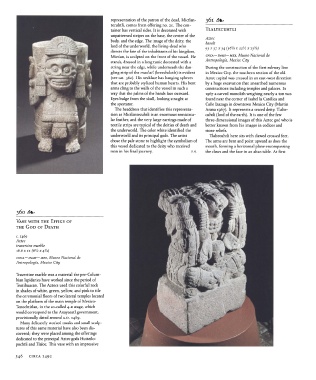Page 547 - Art In The Age Of Exploration (Great Section on Chinese Art Ming Dynasty)
P. 547
representation of the patron of the dead, Mictlan- 361
tecuhtli, comes from offering no. 20. The con-
tainer has vertical sides. It is decorated with TLALTECUHTLI
unpatterned stripes on the base, the center of the Aztec
body, and the edge. The image of the deity, the basalt
lord of the underworld, the living-dead who 93 x 57 x 34 (j6 /s x 22^/2 x i^/s)
5
directs the fate of the inhabitants of his kingdom,
Mictlan, is sculpted on the front of the vessel. He CNCA—INAH—MEX, Museo National de
stands, dressed in a long tunic decorated with a Antropologia, Mexico City
string near the edge, while underneath the dan- During the construction of the first subway line
gling strip of the maxlatl (breechcloth) is evident in Mexico City, the southern section of the old
(see cat. 362). His necklace has hanging spheres Aztec capital was crossed in an east-west direction
that are probably stylized human hearts. His bent by a huge excavation that unearthed numerous
arms cling to the walls of the vessel in such a constructions including temples and palaces. In
way that the palms of the hands face outward. 1967 a carved monolith weighing nearly a ton was
Eyes bulge from the skull, looking straight at found near the corner of Isabel la Catolica and
the spectator. Calle Izazaga in downtown Mexico City (Martin
The headdress that identifies this representa- Arana 1967). It represents a seated deity, Tlalte-
tion as Mictlantecuhtli is an enormous semicircu- cuhtli (lord of the earth). It is one of the few
lar feather, and the very large earrings made of three-dimensional images of this Aztec god who is
textile strips are typical of the deities of death and better known from his images in codices and
the underworld. The color white identified the stone reliefs.
underworld and its principal gods. The artist Tlaltecuhtli here sits with clawed crossed feet.
chose the pale stone to highlight the symbolism of The arms are bent and point upward as does the
this vessel dedicated to the deity who received mouth, forming a horizontal plane encompassing
man in his final journey. F. s. the claws and the face in an altar-table. At first
360
VASE WITH THE EFFIGY OF
THE GOD OF DEATH
c. 1469
Aztec
travertine marble
2
2
16.6 x 11 (6 / 2 x /4J
4
CNCA— INAH— MEX, Museo National de
Antropologia, Mexico City
Travertine marble was a material the pre-Colum-
bian lapidaries have worked since the period of
Teotihuacan. The Aztecs used this colorful rock
in shades of white, green, yellow, and pink to tile
the ceremonial floors of two lateral temples located
on the platform of the main temple of Mexico-
Tenochtitlan, in the so-called 4-6 stage, which
would correspond to the Axayacatl government,
provisionally dated around A.D. 1469.
Many delicately worked masks and small sculp-
tures of this same material have also been dis-
covered; they were placed among the offerings
dedicated to the principal Aztec gods Huitzilo-
pochtli and Tlaloc. This vase with an impressive
546 CIRCA 1492

